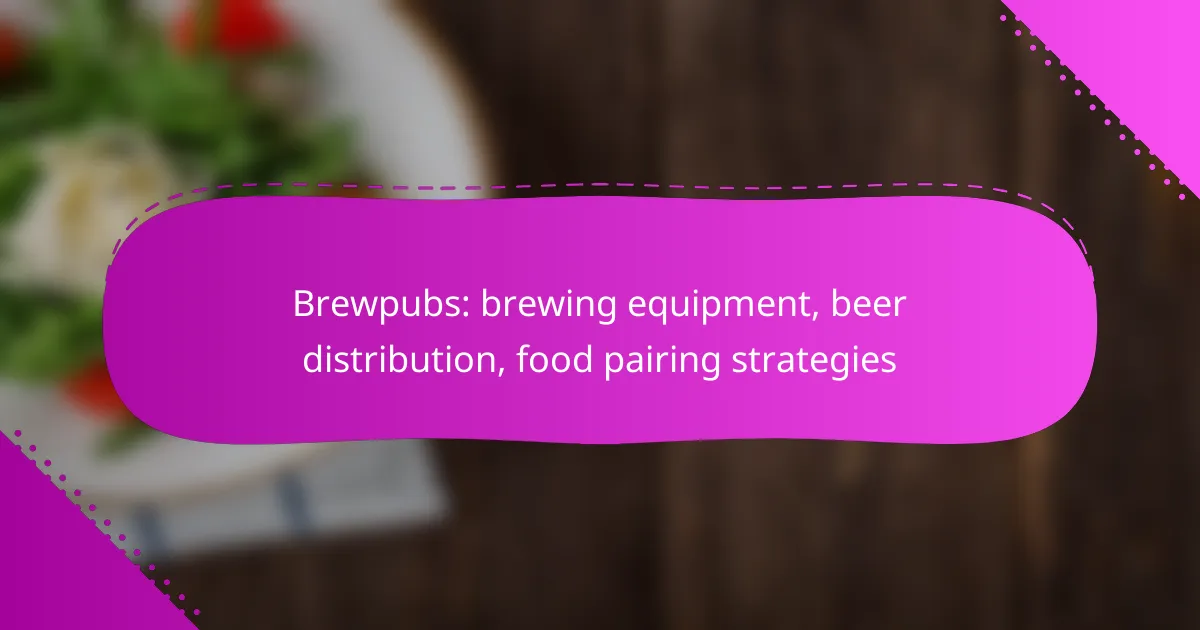Brewpubs offer a unique blend of craft brewing and culinary experiences, making the selection of brewing equipment crucial for success. Understanding local distribution channels and effective strategies can enhance accessibility and reach for your beer. Additionally, mastering food pairing techniques can elevate the dining experience, ensuring that each brew complements the menu perfectly.

How to choose brewing equipment for a brewpub in Canada?
Selecting brewing equipment for a brewpub in Canada involves understanding your production needs, budget, and space constraints. Prioritize systems that align with your brewing style and operational goals while considering local regulations and market preferences.
Essential brewing systems
Essential brewing systems include mash tuns, boil kettles, fermentation tanks, and conditioning tanks. Each component plays a crucial role in the brewing process, from mashing grains to fermenting beer. For a brewpub, a system that allows for flexibility in batch sizes is often beneficial.
Consider systems that integrate well with your food service operations, as this can enhance efficiency and streamline workflow. A compact brewing system may be ideal for smaller spaces, allowing you to maximize both brewing and dining areas.
Top brands for brewpub equipment
Leading brands for brewpub equipment include BrauKon, Blichmann Engineering, and DME Brewing Solutions. These manufacturers offer a range of systems that cater to different production capacities and brewing techniques. Researching customer reviews and case studies can provide insights into the reliability and performance of these brands.
It’s also wise to consider local suppliers who may offer competitive pricing and support services. Building relationships with these suppliers can lead to better deals and assistance with maintenance and repairs.
Budget considerations for equipment
When budgeting for brewing equipment, account for initial costs, installation, and ongoing maintenance. Equipment prices can vary widely, typically ranging from several thousand to tens of thousands of Canadian dollars depending on the scale and complexity of the system.
Additionally, factor in costs for ancillary equipment such as kegs, taps, and cleaning supplies. Setting aside a contingency fund for unexpected expenses can help ensure smooth operations in the early stages of your brewpub.
Space requirements for brewing
Space requirements for brewing depend on the size of your brewing system and the layout of your brewpub. A small system may require as little as 100 square feet, while larger setups could need several hundred square feet to accommodate equipment and storage.
Plan your layout to ensure efficient workflow between brewing, serving, and cleaning areas. Consider local building codes and health regulations that may dictate specific space and ventilation requirements.
Energy efficiency options
Energy efficiency is crucial for reducing operational costs in a brewpub. Look for equipment that utilizes energy-efficient technologies, such as heat exchangers and insulated fermentation tanks, which can significantly lower energy consumption.
Additionally, consider implementing renewable energy sources, such as solar panels, to offset energy costs. Many Canadian provinces offer incentives for businesses that invest in energy-efficient technologies, which can further enhance your savings.

What are effective beer distribution strategies for Canadian brewpubs?
Effective beer distribution strategies for Canadian brewpubs include utilizing local distribution channels, online sales platforms, partnerships with local retailers, and direct-to-consumer shipping. These methods enhance reach and accessibility while catering to the preferences of local consumers.
Local distribution channels
Local distribution channels are vital for brewpubs to connect with nearby customers. This can involve selling directly to bars, restaurants, and local events, which helps build community relationships. Establishing a reliable delivery schedule and maintaining quality control are essential for success in this area.
Consider collaborating with local craft beer festivals or farmers’ markets to showcase your offerings. These venues not only increase visibility but also allow for direct customer interaction, fostering brand loyalty.
Online sales platforms
Online sales platforms are becoming increasingly important for Canadian brewpubs, especially as consumer preferences shift towards convenience. Setting up an e-commerce site or utilizing established platforms can streamline the purchasing process for customers. Ensure that your website is user-friendly and mobile-optimized to enhance the shopping experience.
Promote your online sales through social media and email marketing to reach a broader audience. Offering limited-time promotions or exclusive online products can also incentivize purchases and boost sales.
Partnerships with local retailers
Forming partnerships with local retailers can significantly expand a brewpub’s distribution network. Collaborate with liquor stores, grocery stores, and specialty shops to feature your beers on their shelves. This not only increases visibility but also taps into their established customer base.
Consider offering tasting events or promotional displays in these retail locations to attract attention. Providing retailers with marketing materials can also help them effectively promote your products.
Direct-to-consumer shipping
Direct-to-consumer shipping allows brewpubs to reach customers beyond their immediate geographical area. This method can be particularly effective for specialty or seasonal brews that may not be available in local stores. Ensure compliance with local regulations regarding alcohol shipping, as these can vary by province.
Implementing a robust shipping strategy is crucial. Consider partnering with reliable logistics companies to ensure timely delivery and maintain product quality. Offering flat-rate shipping or free shipping on orders over a certain amount can encourage larger purchases.

How to pair food with beer in a brewpub?
Pairing food with beer in a brewpub involves matching flavors and intensities to enhance the dining experience. Consider the beer’s characteristics, such as bitterness, sweetness, and aroma, alongside the food’s profile to create harmonious combinations.
Popular beer and food pairings
Classic pairings often include hoppy IPAs with spicy dishes, as the bitterness can balance heat. Stouts and porters complement rich desserts like chocolate cake, while lagers work well with lighter fare such as salads and seafood. Experimenting with local craft beers can also yield unique pairings that reflect regional flavors.
Seasonal pairing strategies
Seasonal ingredients can guide your food and beer pairings. In the summer, lighter beers like wheat ales pair nicely with fresh salads and grilled vegetables. In contrast, winter calls for robust ales that match hearty stews and roasted meats. Adjusting your menu seasonally not only enhances flavor but also keeps offerings fresh and appealing.
Menu design for optimal pairings
Designing a brewpub menu with optimal pairings involves clear descriptions that highlight flavor profiles. Grouping items by beer style can help patrons easily identify complementary dishes. Consider offering tasting flights paired with small plates to encourage exploration and enhance the overall dining experience.

What are the key considerations for brewpub licensing in Canada?
When establishing a brewpub in Canada, key considerations for licensing include understanding the specific regulations of the province or territory, the types of licenses required, and the application process. Each region has its own rules governing alcohol production and sales, which can significantly impact operations.
Types of licenses required
Brewpubs in Canada typically need a combination of licenses to operate legally. The most common include a manufacturer’s license for brewing beer and a retail license for selling it on-site. Some provinces may also require food service licenses if food is served alongside the beer.
In addition, brewpubs may need special permits for outdoor seating or events, which can vary by municipality. It’s essential to check local regulations to ensure compliance with all necessary licenses.
Application process for brewpubs
The application process for brewpub licensing generally starts with submitting a detailed business plan to the provincial liquor control authority. This plan should outline the brewpub’s concept, operational procedures, and compliance with health and safety standards.
After the initial submission, applicants may need to undergo inspections and provide additional documentation, such as proof of ownership or lease agreements. The timeline for approval can vary, often taking several weeks to months, so planning ahead is crucial.
Regulatory compliance tips
To maintain compliance, brewpubs should keep thorough records of all brewing and sales activities. Regular training for staff on responsible alcohol service and health regulations is also advisable to avoid potential violations.
Staying informed about changes in local laws and regulations is essential. Joining local brewing associations can provide valuable resources and support for navigating the regulatory landscape effectively.

What are the emerging trends in the brewpub industry?
Emerging trends in the brewpub industry focus on sustainability, innovative beer styles, and technology integration. These trends reflect a growing consumer demand for environmentally friendly practices, unique flavor experiences, and enhanced operational efficiency.
Sustainable brewing practices
Sustainable brewing practices are becoming essential for modern brewpubs, as consumers increasingly prefer environmentally responsible options. Techniques such as water conservation, energy-efficient brewing equipment, and sourcing local ingredients can significantly reduce a brewpub’s carbon footprint.
Implementing a waste management system that includes recycling and composting can further enhance sustainability efforts. Brewpubs can also consider using renewable energy sources, such as solar or wind power, to minimize their environmental impact.
Innovative beer styles gaining popularity
Innovative beer styles are capturing the attention of craft beer enthusiasts, with many brewpubs experimenting with unique ingredients and brewing techniques. Styles like sour ales, barrel-aged stouts, and fruit-infused IPAs are gaining traction, appealing to consumers looking for new taste experiences.
Additionally, non-alcoholic and low-alcohol options are on the rise, catering to health-conscious patrons. Brewpubs can benefit from offering a diverse range of styles to attract a wider audience and encourage repeat visits.
Technology integration in brewpubs
Technology integration is transforming the brewpub experience, enhancing both brewing processes and customer engagement. Automated brewing systems can streamline operations, allowing for consistent quality and reduced labor costs.
Moreover, point-of-sale systems and mobile apps can improve customer service and facilitate online ordering. Brewpubs that leverage technology for inventory management and customer relationship management can optimize their operations and increase profitability.
